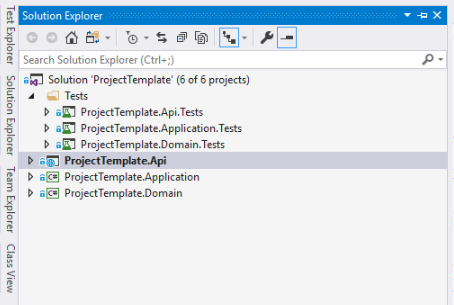Problem
Most of time, starting new project, which can be api, web, console app, microservice or monolithic, big or small,
you need and use mostly the same dependicies such as logging libraries, auth configuration, ORM (for example, entity framework), good practice health checks, api must have swagger documentation and so on. Also you projects structure is not changed a lot.
So there is a good question - why we don’t create template for our and our’s teamates needs. Furthermore, if you don’t need some of template’s dependencies, it is always easy to remove them at start time of development.
Solution
Fortunately, dotnet allows us create our custom template in few easy steps.
Project
First of all, we have to create solution or just project for your template. In my case, I’ve created solution with structure based on DDD. So I have API - infrastrucure, Application layer and Domain layer. Also for all layers I created xUnit test projects.

Dependencies
Now, you can add necessary dependies to your project. Let’s add basic firstly.
Entity framework
dotnet install Npgsql.EntityFrameworkCore.PostgreSQL
Our appsettings.json
{
"Logging": {
"LogLevel": {
"Default": "Debug",
"System": "Warning",
"Microsoft": "Warning"
}
},
"ConnectionStrings": {
"{{Database_Name}}": "User ID=postgres;Password=postgres;Host=localhost;Port=15432;Database={{Database_Name}};Pooling=true;",
},
"AllowedHosts": "*"
}
Note, we use name of connection string and database name as {{Database_Name}}. It allows template to use it like a variable for replacing it during generating.
Now we need to create DbContext
namespace ProjectTemplate.Api.Data
{
public class DatabaseContext : DbContext
{
public DatabaseContext(DbContextOptions<DatabaseContext> options)
: base(options)
{ }
protected override void OnModelCreating(ModelBuilder modelBuilder)
{
}
}
}
Startup.cs
public void ConfigureServices(IServiceCollection services)
{
services.AddMvc().SetCompatibilityVersion(CompatibilityVersion.Version_2_2);
services.AddDbContext<DatabaseContext>(options =>
options.UseNpgsql(Configuration.GetConnectionString("{{Database_Name}}")));
}
Note, we again use string {{Database_Name}} which will be replace with our real database name
Nlog
Every project needs logging. I use nlog most of time.
dotnet install Nlog
dotnet install NLog.Web.AspNetCore
Don’t forget add nlog.config. And our Program.cs looks like
public class Program
{
public static void Main(string[] args)
{
// NLog: setup the logger first to catch all errors
var logger = NLog.Web.NLogBuilder.ConfigureNLog("nlog.config").GetCurrentClassLogger();
try
{
logger.Debug("Starting program");
CreateWebHostBuilder(args).Build().Run();
}
catch (Exception ex)
{
//NLog: catch setup errors
logger.Error(ex, "Stopped program because of exception");
throw;
}
finally
{
// Ensure to flush and stop internal timers/threads before application-exit (Avoid segmentation fault on Linux)
NLog.LogManager.Shutdown();
}
}
public static IWebHostBuilder CreateWebHostBuilder(string[] args) =>
WebHost.CreateDefaultBuilder(args)
.UseStartup<Startup>()
.ConfigureLogging(logging =>
{
logging.ClearProviders();
logging.SetMinimumLevel(Microsoft.Extensions.Logging.LogLevel.Debug);
})
.UseNLog();
}
So now, we have 2 dependencies in our template. Of course, you can add any dependencies you want. Let’s now generate our first template.
Template
Firstly, we have to create folder in the root of solution and name it .template.config. There will be one file with name template.json and content
{
"$schema": "http://json.schemastore.org/template",
"author": "Your name",
"classifications": [ "Web/API/Nlog/Entity framework core" ],
"name": "Night backer template",
"identity": "nightApi",
"shortName": "nightApi",
"tags": {
"language": "C#",
"type": "project"
},
"sourceName": "ProjectTemplate", // every entry of this string in source code or in project names will be replace with given value
"preferNameDirectory": true,
"symbols": { // this section allows to replace our variables with given value during generating project from template
"db": {
"type": "parameter",
"isRequired": "true",
"datatype": "string",
"replaces": "{{Database_Name}}",
"defaultValue": "MyGameStartupDB",
"description": "The database name attached to this project."
}
}
}
Our template is ready. Run following command in console in root of solution to install this template to your environment
dotnet new -i .
If there is no error, you should see a list of installed templates
You can generate new project from our template, for example :
dotnet new nightApi –db <Database_name> -n <Project_name>.
Replace following values :
<Database_name> is our variable for database name
<Project_name> is a project name
Nuget package
Using whole solution for creation of template is not so convinient way, for example, if your teammate want’s to use your prepared template. So you may want to share it easily like nuget package. Fortunately, it is as much simple as creating template.
- Let’s create folder and name it
ProjectTemplatePackage. - Copy our project folder into just created folder.
- Create file
ProjectTemplates.csprojwith content :
<Project Sdk="Microsoft.NET.Sdk">
<PropertyGroup>
<PackageType>Template</PackageType>
<PackageVersion>1.0</PackageVersion>
<PackageId>NightBacker.Templates</PackageId>
<Title>Templates for .net</Title>
<Authors>Night backer</Authors>
<Description>Templates to use when creating an application.</Description>
<PackageTags>dotnet-new;api;nlog;ef core</PackageTags>
<TargetFramework>netstandard2.0</TargetFramework>
<IncludeContentInPack>true</IncludeContentInPack>
<IncludeBuildOutput>false</IncludeBuildOutput>
<ContentTargetFolders>content</ContentTargetFolders>
</PropertyGroup>
<ItemGroup>
<Content Include="ProjectTemplate\**\*" Exclude="ProjectTemplate\**\bin\**;ProjectTemplate\**\obj\**" />
<Compile Remove="**\*" />
</ItemGroup>
</Project>
- Run command
dotnet pack
Now in ProjectTemplatePackage\bin\Debug you can see your created nuget package.
If you want to install template from nuget package use following command
dotnet new -i <PATH_TO_NUPKG_FILE>
